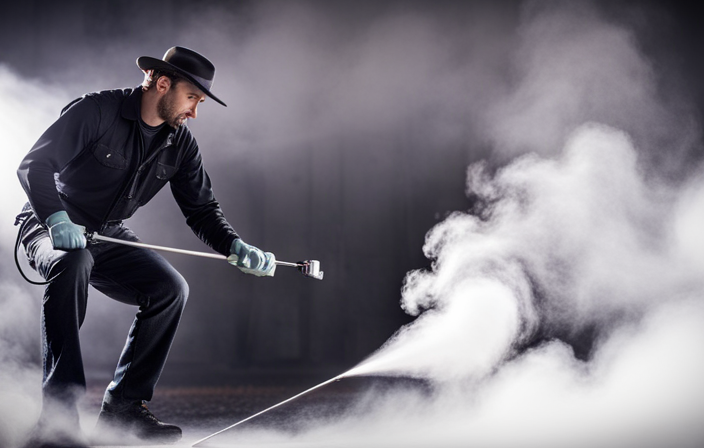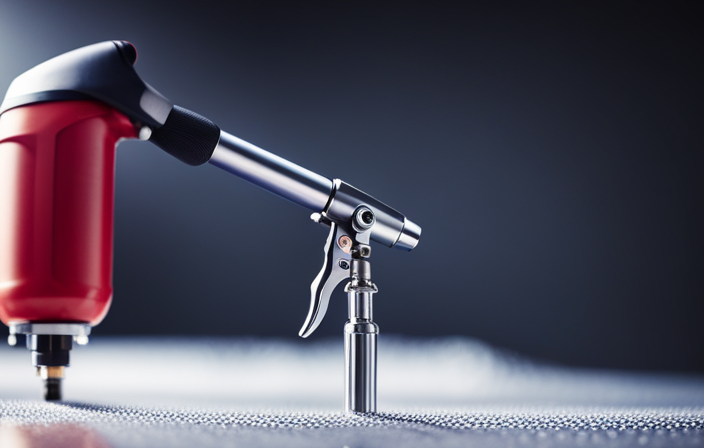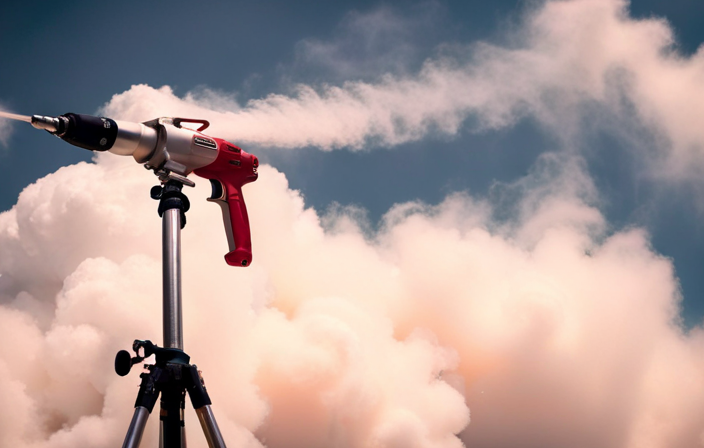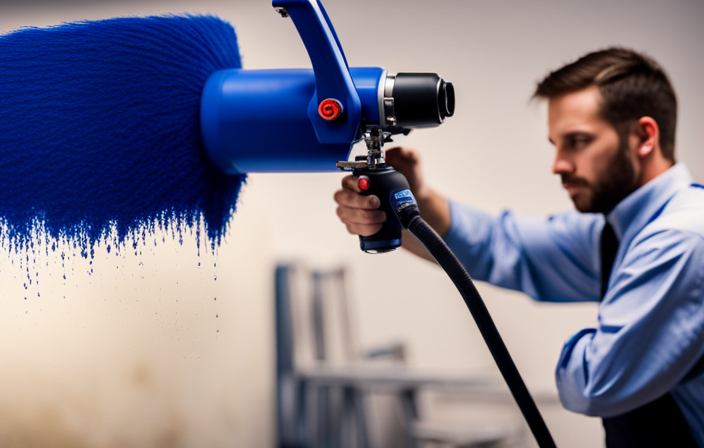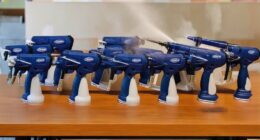I remember my first try at painting a ceiling with a brush and roller. It was a messy, time-consuming task that left me with a sore back and a streaky paint job.
Thankfully, I discovered a game-changer: painting ceilings with an airless sprayer. With this powerful tool, I was able to achieve professional-looking results in half the time.
In this article, I will guide you through the process of painting ceilings with an airless sprayer, sharing tips and techniques to ensure a smooth and flawless finish. From preparing the room to choosing the right paint and equipment, to mastering the proper sprayer technique, I will cover it all.
So, if you’re ready to say goodbye to backaches and hello to a beautifully painted ceiling, let’s dive in and get started!
Key Takeaways
- Airless sprayers are a game-changer for painting ceilings, as they help achieve professional-looking results in half the time.
- Proper preparation, including cleaning the ceiling thoroughly and choosing the right paint type, is essential before using an airless sprayer.
- Spraying technique is important, including holding the sprayer at the correct angle, maintaining a consistent distance from the ceiling, and using overlapping strokes for even coverage.
- Regularly clean and maintain the sprayer to prevent clogs and ensure consistent paint flow, and address any troubleshooting or maintenance issues that may arise.
Prepare the Room
Now, let’s get your room ready for the ultimate ceiling transformation with an airless sprayer! Before you start painting, it’s essential to organize the room properly.
Remove any furniture, decorations, and fixtures from the area to prevent them from getting paint splatters.
Cover the floor and walls with drop cloths or plastic sheets to protect them from accidental spills or overspray.
Next, prepare the ceiling by cleaning it thoroughly to ensure the paint adheres well. Remove any dirt, dust, or cobwebs using a broom or vacuum cleaner.
If there are any stains or grease marks, wash them off with a mild detergent and water solution.
Once the room is organized and the ceiling is prepped, it’s time to move on to choosing the right paint and equipment for the job.
Choose the Right Paint and Equipment
When it comes to choosing the right paint and equipment for painting ceilings with an airless sprayer, there are three key points to consider.
First, it’s important to select the appropriate paint type for the job, taking into account factors such as the surface, finish, and color.
Second, you may need to purchase or rent an airless sprayer, depending on your budget and the frequency of use.
Finally, don’t forget to gather the necessary safety equipment, such as goggles, gloves, and a respirator, to protect yourself during the painting process.
Select the Appropriate Paint Type
First, you’ll need to choose the right paint type for your ceiling, which accounts for 15% of the overall success in achieving a flawless finish with an airless sprayer. When selecting the appropriate finish, consider the ceiling texture.
Here are three essential factors to consider when choosing the paint type:
-
Durability: Opt for a paint that’s specifically designed for ceilings and offers long-lasting durability.
-
Coverage: Look for a paint that provides excellent coverage to ensure a smooth and even finish.
-
Reflectivity: Consider using a paint with a high reflectivity level to maximize the natural light in your space.
By carefully selecting the right paint type, you’ll be on your way to achieving a professional-looking ceiling with an airless sprayer.
Now, let’s move on to the next section about purchasing or renting an airless sprayer.
Purchase or Rent an Airless Sprayer
If you’re ready to tackle your ceiling project, it’s time to decide whether to buy or lease the powerful tool you’ll need.
Renting an airless sprayer can be a cost-effective option, especially if you don’t plan on using it frequently. Rental costs for airless sprayers can vary depending on your location and the duration of the rental.
It’s important to consider the pros and cons of renting. On the positive side, renting allows you to access a high-quality sprayer without making a large upfront investment. Additionally, you won’t have to worry about maintenance or storage when you’re done. However, renting may not be ideal if you anticipate needing the sprayer for multiple projects or if the rental costs are high.
With that in mind, let’s move on to the next section and gather the necessary safety equipment.
Gather Safety Equipment
To ensure your safety during the project, make sure to gather all the necessary protective gear. Proper ventilation is crucial when painting ceilings with an airless sprayer. The paint fumes can be harmful if inhaled for an extended period of time, so open windows and use fans to circulate fresh air. It’s essential. Additionally, wearing a respirator provides an extra layer of protection by filtering out harmful particles in the air. There are different types of safety goggles available, such as wraparound goggles or goggles with side shields, which effectively shield the eyes from paint splatters and debris. It’s important to choose goggles that fit securely and provide a clear field of vision.
Now, let’s move on to the next section and discuss how to practice proper sprayer technique.
Practice Proper Sprayer Technique
When it comes to painting ceilings with an airless sprayer, it’s important to practice proper technique.
Holding the sprayer at the correct angle is crucial for achieving a smooth and even finish.
Maintaining a consistent distance from the ceiling ensures that the paint is applied evenly without any drips or splatters.
Using overlapping strokes is also important as it helps to provide complete coverage and eliminate any streaks or unevenness in the paint.
Hold the Sprayer at the Correct Angle
While holding the sprayer at the correct angle, you’ll achieve a smooth and even coat of paint on your ceilings. Did you know that using an airless sprayer can cover up to 10 times more surface area than traditional painting methods? To achieve the best results, follow these steps:
-
Maintain the correct spray technique: Hold the sprayer approximately 12 inches away from the ceiling surface. This distance allows for better spray pattern control and prevents overspray.
-
Control the spray pattern: Move the sprayer in a steady, side-to-side motion, overlapping each pass by about 50%. This technique ensures consistent coverage and avoids streaks or uneven patches.
-
Keep the sprayer perpendicular to the ceiling: Holding the sprayer at a right angle to the surface helps maintain an even distribution of paint and prevents drips.
-
Adjust the sprayer settings: Experiment with different nozzle sizes and pressure settings to find the right combination for your specific ceiling and paint type.
By mastering these techniques, you’ll be ready to move on to the next step: maintaining a consistent distance from the ceiling.
Maintain a Consistent Distance from the Ceiling
After holding the sprayer at the correct angle, it’s crucial to maintain a consistent distance from the ceiling when using an airless sprayer. This is key to achieving an even and professional-looking finish. By keeping a steady distance, you can ensure that the paint is applied evenly and avoid any inconsistencies or patchiness.
Additionally, maintaining a consistent spraying technique helps to prevent overspray, which can lead to wasted paint and a messy work area. To achieve this, I recommend practicing your spraying technique on a scrap piece of cardboard or plywood before starting on the actual ceiling. This will allow you to get a feel for the distance and control needed. By mastering this technique, you’ll be ready to move on to the next step of using overlapping strokes for even coverage.
Use Overlapping Strokes for Even Coverage
To achieve a flawless and professional finish, it’s essential to master the technique of using overlapping strokes. This technique ensures even coverage and avoids any streaks or patchiness on the ceiling. Here are three overlapping techniques that can help you achieve a smooth finish:
-
Start at one corner of the ceiling and work your way across in a straight line, using the sprayer to apply a steady stream of paint. As you move across, slightly overlap each stroke with the previous one to blend the paint together.
-
When you reach the end of a row, move the sprayer back to the starting point and slightly overlap the previous row. This helps to avoid any gaps or unevenness between rows.
-
Continue this process, working in small sections at a time, until the entire ceiling is covered. Remember to keep a consistent distance from the ceiling and maintain a steady pace to ensure an even application.
By using these overlapping techniques, you can achieve a smooth finish that’ll make your ceiling look professionally painted.
Now, let’s move on to the next section and start painting.
Start Painting
When starting to paint, I always begin in a corner or edge to ensure smooth and even coverage. This helps me avoid leaving any gaps or uneven lines.
Then, I make sure to apply an even coat of paint, using long, even strokes to achieve a professional finish.
Lastly, I work in small sections at a time, focusing on one area before moving on to the next. This allows me to maintain control and prevent the paint from drying too quickly.
Begin in a Corner or Edge
First, make sure to position yourself in a corner or edge and begin spraying the ceiling with the airless sprayer. Did you know that using an airless sprayer can save you up to 75% of your painting time compared to using a brush or roller? When dealing with corners and edges, it’s important to be mindful of overspray in tight spaces. To ensure a clean and professional finish, follow these tips:
| Tips for Dealing with Corners and Edges | |
|---|---|
| 1 | Use a smaller spray tip for better control in tight areas. |
| 2 | Hold the sprayer at a slight angle to avoid overspray on adjacent walls. |
| 3 | Move the sprayer in a smooth and steady motion, overlapping each pass slightly. |
| 4 | Pay extra attention to corners and edges, ensuring even coverage. |
| 5 | Practice on a scrap piece of cardboard to get comfortable with the sprayer’s settings and technique. |
By following these guidelines, you’ll be able to navigate corners and edges with ease and avoid any unwanted overspray. Now, let’s move on to the next section and learn how to apply an even coat of paint.
Apply an Even Coat of Paint
After starting in a corner or edge, the next step in painting ceilings with an airless sprayer is to apply an even coat of paint. This is crucial for achieving a professional and seamless finish. To ensure an even coat, follow these steps:
-
Adjust the sprayer settings: Before starting, check the sprayer’s pressure and fan width settings to ensure they’re appropriate for the job.
-
Maintain the sprayer: Regularly clean and maintain the sprayer to prevent clogs and ensure consistent paint flow.
-
Troubleshooting techniques: If you encounter any issues like spitting or uneven spray, troubleshoot by checking the paint viscosity, nozzle condition, or adjusting the pressure.
-
Start spraying: Hold the sprayer 12-18 inches away from the ceiling and use steady, overlapping strokes to apply the paint evenly.
By applying an even coat of paint, you’ll achieve a professional-looking ceiling.
Now, let’s move on to the next section about working in small sections.
Work in Small Sections
To achieve a flawless finish, it’s essential to break down your painting tasks into smaller, manageable sections. Working in small sections offers several benefits.
Firstly, it allows you to focus on a specific area, ensuring that you apply an even coat of paint without rushing or missing spots. Secondly, it helps prevent the paint from drying too quickly, giving you more time to work it into the surface and eliminate any streaks or drips.
To work efficiently in small sections, start by dividing the ceiling into manageable areas using tape or chalk lines. Then, apply the paint in smooth, overlapping strokes, moving from one section to another.
Take breaks between sections to monitor and adjust the paint flow, ensuring consistent coverage. This approach ensures a professional-looking finish without any visible seams or uneven patches.
Monitor and Adjust the Paint Flow
While operating the airless sprayer, it’s crucial to keep an eagle eye on the paint flow and make necessary adjustments. Here are a few important things to remember when monitoring and adjusting the paint flow:
- Check the spray pattern regularly to ensure it’s even and consistent.
- If the spray pattern is uneven or splotchy, adjust the pressure and nozzle size accordingly.
Pay attention to the thickness and viscosity of the paint, as it can affect the flow rate.
Clean the spray tip regularly to prevent clogging and maintain a steady flow.
If there are any issues with the paint flow, troubleshoot by checking the pump, filters, and hoses for any blockages or malfunctions.
Remember, achieving a smooth and flawless finish requires precise adjustments to the paint flow. Once you’ve mastered this skill, you can proceed to apply multiple coats if necessary.
Apply Multiple Coats if Necessary
For a truly flawless finish, don’t hesitate to apply multiple coats if needed; it’s all about achieving perfection. When using an airless sprayer to paint ceilings, applying additional layers can help ensure even coverage and a smooth, professional result.
However, it’s important to manage the drying time between coats to prevent any issues with the paint drying unevenly or forming clumps. Allow each coat to dry completely before applying the next one, following the manufacturer’s instructions for drying time. You may need to adjust the drying time based on the specific paint you’re using and the conditions in the room.
By applying multiple coats and managing the drying time effectively, you can achieve a flawless finish that will make your ceilings look brand new.
As we move on to the next section about cleaning and maintaining the sprayer, it’s important to keep in mind the importance of regular maintenance to ensure the longevity and optimal performance of your equipment.
Clean and Maintain the Sprayer
Keep your equipment in top shape by regularly cleaning and maintaining the tool that helps bring your painting dreams to life. Here are some sprayer maintenance tips to ensure optimal performance:
- Flush the sprayer with clean water after each use to prevent clogs and buildup.
- Check the filters regularly and clean or replace them as needed.
- Lubricate the moving parts, such as the piston and seals, to prevent friction and ensure smooth operation.
- Inspect the spray tip for any damage or blockage, and replace if necessary.
- Store the sprayer in a clean and dry place to prevent rust and damage.
Troubleshooting common issues can save you time and frustration. If the sprayer doesn’t spray evenly, check for clogs or worn parts. If it doesn’t start, make sure the power source is connected properly.
Now that your sprayer’s well-maintained, let’s move on to removing protective coverings and furniture.
Remove Protective Coverings and Furniture
Before I can finish painting the ceiling with an airless sprayer, I need to carefully remove the masking tape and plastic coverings that were protecting the walls and floors.
Once that’s done, I’ll clean up any paint splatters and replace the furniture that was temporarily moved out of the way.
Finally, I’ll inspect the room for any touch-ups or repairs that may be needed before considering the project complete.
Carefully Remove Masking Tape and Plastic Coverings
Gently peel off the masking tape and carefully remove the plastic coverings to reveal your beautifully painted ceiling. Removing the tape and plastic coverings is an important step in the painting process, as it allows you to see the finished result and ensures that no paint is left behind.
When removing the tape, take your time and pull it off slowly to avoid any damage to the paint or the ceiling surface. As for the plastic coverings, fold them up neatly and dispose of them properly.
Now that the coverings are gone, you can move on to the next step of cleaning and replacing your furniture.
Clean and Replace Furniture
After carefully removing the masking tape and plastic coverings, it’s time to clean and replace the furniture before moving on to the next step. Cleaning the furniture is essential to ensure that no paint residue or dust is left behind, which could affect the final result. Here are some cleaning tips to help you get started:
- Dust: Use a soft cloth or feather duster to remove any dust from the furniture surfaces.
- Vacuum: Use a handheld vacuum or brush attachment to remove any loose dirt or debris from upholstery or cushions.
- Spot cleaning: For stains or spills, refer to the manufacturer’s instructions or use a mild detergent mixed with water to gently clean the affected area.
Once the furniture is clean, carefully place it back in the room, ensuring that it is positioned away from the walls to allow for easy painting access. Now, it’s time to inspect the room for any touch-ups or repairs before proceeding.
Inspect the Room for any Touch-ups or Repairs
First, take a walk around the room and inspect it for any touch-ups or repairs that may be needed. This could include a small crack on the baseboard or a chipped corner on the window frame. As I inspect the room, I notice a small dent on the doorframe that needs to be filled and sanded before painting. Touch-up techniques are essential to ensure a flawless finish on the ceiling. It’s important to address any imperfections before applying paint with an airless sprayer.
Additionally, repairing ceiling cracks is crucial to achieve a smooth and professional-looking result. By carefully examining the room and addressing any necessary repairs, you can ensure that your finished ceiling will be perfect.
Now, let’s move on to the next section and admire your beautifully painted and repaired ceiling.
Admire Your Finished Ceiling
As I step back and take in the view, I’m amazed at the flawless finish of my newly painted ceiling. The airless sprayer’s done a fantastic job, leaving no streaks or brush marks behind.
Now that the ceiling is complete, I can focus on showcasing it in the best possible light. One idea is to consider different lighting options that’ll accentuate the color and texture of the ceiling. Recessed lighting or track lighting can create a dramatic effect, while pendant lights can add a touch of elegance.
Additionally, choosing the perfect color for the ceiling is crucial. Lighter shades can make the room feel more spacious, while darker tones can add depth and warmth.
Now that my ceiling’s a work of art, it’s time to share my experience with others.
Share Your Experience
Now that you’ve finished painting your ceiling with an airless sprayer and taken a moment to admire your hard work, it’s time to share your experience with others.
Sharing your tips and tricks can be helpful for those who are new to using an airless sprayer or are looking for advice on how to achieve a professional-looking finish.
You can share your experience on social media platforms, online forums, or even with friends and family who may be interested in tackling a similar project.
Don’t forget to ask for advice as well! There’s always room for improvement, and by seeking input from others, you can continue to refine your technique and achieve even better results in the future.
Frequently Asked Questions
What safety precautions should I take when using an airless sprayer to paint ceilings?
When using an airless sprayer to paint ceilings, it is crucial to prioritize safety. Ensure proper ventilation and wear protective goggles to prevent inhalation of fumes and protect your eyes from paint particles.
Can I use an airless sprayer to paint textured ceilings?
Textured ceilings can be challenging to paint with an airless sprayer. Only 20% of DIYers attempt it due to the risk of clogging. Consider using a roller or a texture sprayer for better results.
How do I avoid overspray when using an airless sprayer to paint ceilings?
To avoid overspray when using an airless sprayer on ceilings, I recommend adjusting the spray pressure and fan width, using drop cloths to protect the surrounding area, and practicing proper technique. Afterward, clean the sprayer thoroughly to avoid clogs and drips.
Can I use an airless sprayer to paint ceilings with popcorn texture?
Yes, you can use an airless sprayer to paint ceilings with popcorn texture. However, it’s important to note that the popcorn texture may need to be removed before painting, or you can consider alternative methods for painting ceilings.
What type of paint is best suited for airless spraying on ceilings?
The best type of paint for airless spraying on ceilings is a latex or acrylic paint. It offers quick drying time, easy cleanup, and excellent coverage. To achieve a smooth finish, use a high-quality paint and follow proper technique, such as maintaining a consistent distance and applying multiple thin coats.
Conclusion
After following these steps and putting in some hard work, I must say that painting my ceiling with an airless sprayer was worth every second. The result is like a breath of fresh air, a beautiful masterpiece that adds a touch of elegance to my room.
So don’t be afraid to grab that sprayer and transform your ceiling into a work of art. Trust me, you won’t regret it. Happy painting!

